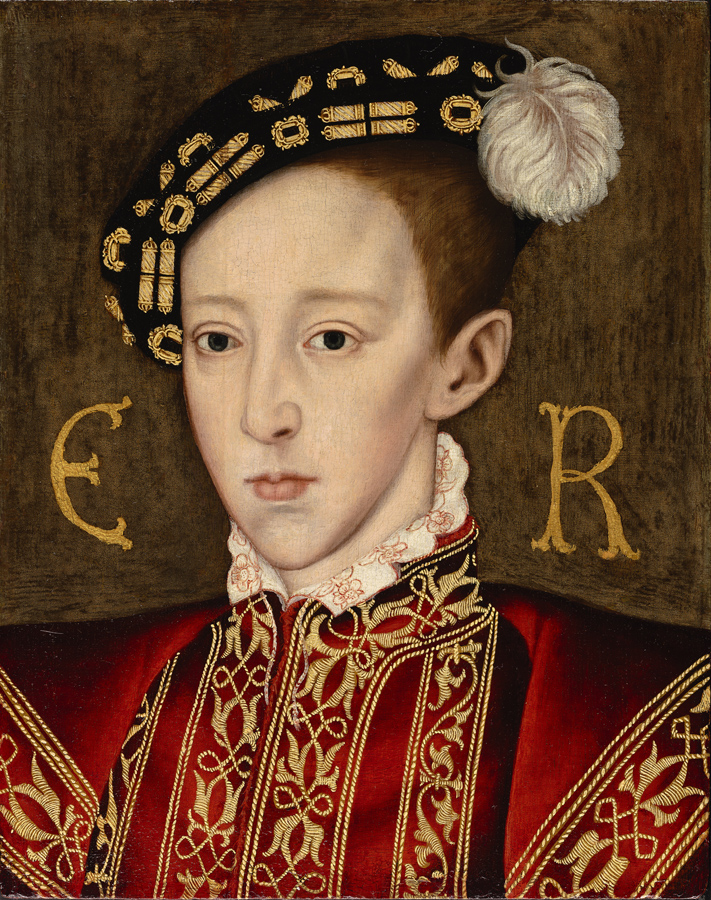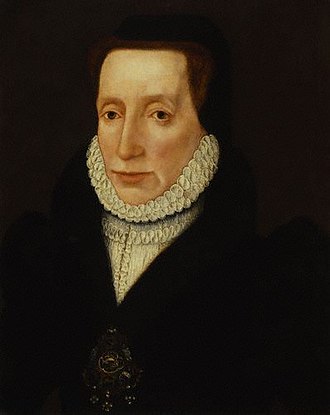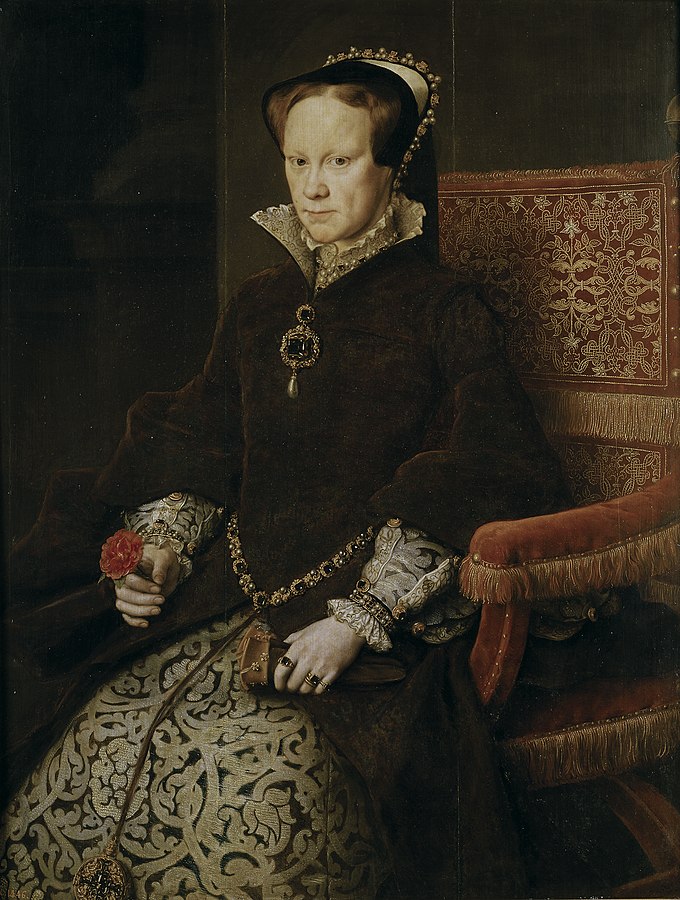Lady Jane Grey Becomes Queen of England, 1553
 |
| Only 16 years old, Jane Grey reigned for exactly 9 days. |
Was This Even Legal?
Henry VIII, as you probably recall, had some real problems with his quest for a male heir. Finally, he produced a son, Edward VI, with his third wife, Jane Seymour. Edward became king after Henry's death, at the age of nine. He was only 15 when he died.Henry had produced only four children who lived past infancy. (Another seven had died either in the womb or shortly after birth.) There was Mary, the daughter of his first wife, Katherine of Aragon. There was Elizabeth, the daughter of Anne Boleyn. Edward was his only legitimate male heir. There had also been an illegitimate son, Henry Fitzroy, who had died the year before Edward was born.
 |
| Edward wanted a Protestant successor. |
Edward, as he approached manhood, had different ideas. Although he was fond of his sister Mary, she was a devout Catholic and Edward was almost as determined a Protestant. He did not wish England to become a Catholic nation, and he had no doubt that Mary would see to it that it did if she ever became queen. Elizabeth, on the other hand, was a nominal Protestant, but Edward wasn't too sure just how deeply her Protestantism went. Perhaps he felt that Elizabeth would bend whichever way the wind blew, when it came to religion. If he did think so, he wasn't far wrong.
As Edward came into his teen years and his health began to fail, he began to think seriously about what would happen to the realm when he was gone. He penned a "device" -- a document dictating the order of succession after his death. Since he was still a minor, any will he wrote wasn't really binding, and even as king he couldn't override an act of Parliament, but he wrote it nevertheless. It would be up to those who survived him to make sure it took effect.
Edward's "Device"
 |
| You can see where Edward edited his work. |
Henry VIII had had two sisters, Margaret and Mary. Margaret, the elder, had been married twice, first to the King of Scotland, and then, after he died, to Archibald Douglas, the Earl of Angus. The second marriage had proved rocky and had ended in divorce, giving rise to speculations of illegitimacy regarding their daughter, Margaret. Margaret Douglas still lived, as did Mary Stuart, granddaughter of Margaret's from her first, royal marriage. Mary Stuart became Queen of Scots when she was 10 years old, and was, like Mary Tudor, a strong Catholic.
 |
| Mary Stuart was Margaret Tudor's grand-daughter |
 |
| Margaret Douglas was still alive, too. |
Edward's device initially left the throne to first, any male heirs which Frances Grey might yet produce, and then, to any male heirs of Jane, Katherine, or Mary. Edward was only ill at this point.
When he felt death approaching, he amended his document. Where it had previously read "to Lady Jane's male heirs" he changed it to "Lady Jane and her male heirs."
From Edward's point of view, it was a logical decision. It helped, of course, that Jane was a serious-minded, devout Protestant.
After Edward's Death
 |
| Mary Tudor had her own ideas about the succession, and the support to achieve them. |
The Privy Council seemed more than willing to have Lady Jane as their monarch, and she was proclaimed Queen of England on July 10, 1553, four days after Edward's death. She took up temporary residence in the Tower of London, the traditional home for British monarchs between their ascension to the throne and their actual coronation. Her husband, Guildford, wanted her to name him King of England, but she refused to do so without the consent of Parliament. As a consolation, she made him Duke of Clarence. "I will not be Duke, I will be King," Guildford replied.
Mary Tudor meanwhile had ridden north as soon as Edward's death was confirmed. She was off to rally her supporters.
Mary Wins
 |
| John Dudley, Duke of Northumberland, and Jane's father-in-law. |
No sooner was Northumberland out of town than the Privy Council decided to switch their loyalties to Mary. Jane and her husband, already conveniently residing in the Tower, were simply switched to other apartments. They were now both prisoners of the Crown.
Northumberland was executed for treason almost immediately. Jane and Guildford were charged with treason, tried, and found guilty. They were both sentenced to death. Jane's was to take the form of being burned alive (the traditional death for females convicted of treason) or beheaded -- at the Queen's choice. It appeared, however, that the Queen was disposed to be merciful.
Complications
 |
| In a separate rebellion, Jane's father sought to put Elizabeth on the throne. |
In England, objections to the marriage took the form of a rebellion led by four English nobles. The plan was to overthrow Mary, put Elizabeth on the throne and marry her to her cousin, Edward Courtenay. The planned uprising, known as Wyatt's Rebellion, was caused by a mixture of political and religious motives. One very strong motive was the fear that the combined forces of Mary and Phillip would bring the Spanish Inquisition to England.
The leaders of the rebellion were Thomas Wyatt, James Croft, Peter Carew, and Lady Jane's father, Henry Grey. Among the many casualties of the quelled rebellion were Lady Jane and her husband, who had had nothing to do with it. Pressured by Charles of Spain, and anxious to eliminate Jane as a focus of future dissent, Mary ordered both Jane and Guilford executed.
The End of Jane
Guilford was executed first, beheaded in public on Tower Hill. His remains were brought back to the Tower of London in a horse and cart that passed immediately outside Jane's window. Jane was taken to the Tower Green (inside the Tower) and executed privately, a privilege generally afforded only to the royal family.Jane gave her forgiveness to her executioner, and then blindfolded herself. Once blindfolded, she had difficulty finding the block and began to panic, but was led to it and was able to regain her dignity. Her last words were, "Lord, into thy hands I commend my spirit."
.jpg/1077px-PAUL_DELAROCHE_-_Ejecuci%C3%B3n_de_Lady_Jane_Grey_(National_Gallery_de_Londres%2C_1834).jpg) |
| Jane had a little trouble finding the block once she was blindfolded, but died with dignity. |
No comments:
Post a Comment